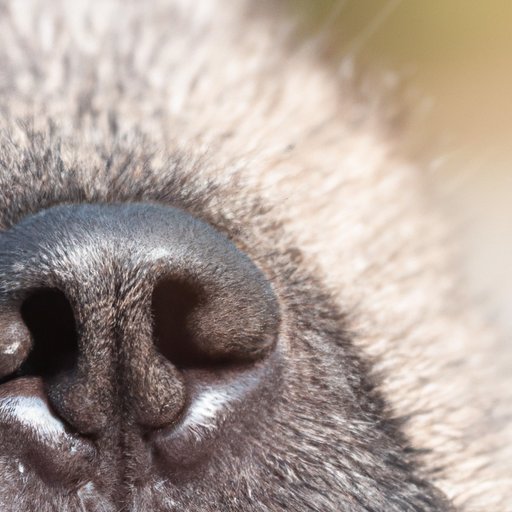
Introduction
Dogs are amazing animals that possess incredible sensory abilities. Among their many unique features are their whiskers. These long, delicate hairs on a dog’s face may seem inconsequential, but they play an essential role in their sensory experience. With that said, is it okay to cut dog whiskers? In this article, we’ll explore the importance of dog whiskers, the risks of cutting them, and the debate surrounding their removal.
The Importance of Dog Whiskers and Why You Shouldn’t Cut Them
Dog whiskers, also called vibrissae, are highly sensitive hairs that are deeply rooted in the skin. They are typically twice as thick as the normal coat hair, which makes them more durable and flexible. Whiskers come with sensory nerves at their roots responsible for messaging the brain about what is going on around the dog. They are sensitive to air currents and movement, giving canines a way to perceive the environment around them, even in total darkness. They can sense the slightest changes in air current, which can alert them about the approach of a predator, enabling them to know when to move, stop, or react in various ways.
Cutting dog whiskers could impair the quality of life that dogs enjoy by causing sensory deprivation. By removing the primary means of their environmental perception, you create a stressful and potentially dangerous situation. Dogs use their whiskers to gather essential information, detect obstacles, and even sense possible danger. In simple terms, removing a dog’s whiskers can be quite detrimental.
The Debate Over Cutting Dog Whiskers
The issue of whether to cut your dog’s whiskers all boils down to a public debate that has never been resolved. Some people are opposed to cutting dog whiskers, while others believe it is necessary. The truth is, both arguments have valid points, and the decision should ultimately come down to the dog’s wellbeing.
Those people who support cutting dog whiskers argue that they can become a safety hazard for certain breeds of dogs. For instance, long-haired breeds may require the whiskers around the eyes to be trimmed since they can get in their dog’s way, be a place to trap dirt or grime and even cause eye irritation. Some people who show dogs can remove their whiskers primarily to improve their appearance, which is not actionable at home.
Understanding Your Dog’s Whiskers
Depending on the breed, dogs have multiple types of whiskers. They can be classified into four groups, including: first-order, second-order, third-order, and accessory whiskers, each with its specific function. First-order whiskers aid in aiding the dog’s perception of the environment. Second-order whiskers are used for identification, while third-order whiskers assist in interpreting the environment and balancing the dogs. Accessory whiskers enhance the dog’s capability to sense and discriminate fine textures.
While the whiskers on your dog’s snout are long and obvious, they are not the only ones they have. Dogs also have whiskers on their chin, above their eyes, and on their legs. These different types of whiskers are just as sensitive and essential for a dog’s sensory perception. Your dog’s whiskers might seem strange or annoying to you, but to them, they mean the world.
The Dangers and Risks of Cutting Dog Whiskers
Cutting your dog’s whiskers can lead to a few adverse effects. With very few blood vessels in them, cutting them will lead to no bleeding, making it hard to notice the harm. Here are the dangers and risks of cutting your dog’s whiskers:
Disorientation and Confusion
Removal of whiskers disrupts your dog’s sensory system, which can lead to confusion and disorientation. Whiskers give dogs important spatial information that helps with movement and perception.
Behavioral Changes
Your dog can exhibit behavioral changes after whisker removal. Whiskerless dogs can become more agitated, and lack of stimuli can lead to your dog becoming bored and restless.
Physical Injury and Pain
When removing whiskers, there is the possibility of inflicting discomfort and injury to the nerve endings. Repeated cutting can cause nerve damage that delays recovery, leading to chronic pain.
The Ethics of Cutting Dog Whiskers
Cutting dog whiskers is an ethical debate, with pros and cons. Some people believe it’s okay, while others view it as interfering with a dog’s natural sensory mechanisms. It would be best to understand that whiskers are crucial in a dog’s survival and well-being. Moreover, cutting whiskers deprives them of sensory information that they depend on every day to function well.
While there may be some scenarios where whiskers need to be cut, for example, to manage a medical or grooming condition carefully, cutting them purely for aesthetic reasons creates more harm than good.
Conclusion
Dog whiskers may seem like an annoying feature to pet owners, but to dogs, they are an important and essential sensory tool. In conclusion, cutting dog’s whiskers is not a good idea and can cause severe harm to your pet. Even though some people may feel the need to cut their dog’s whisker, it usually isn’t necessary in many dog breeds. By understanding the importance of dog whiskers, you can make an informed decision about whether or not to cut or trim your dog’s whiskers. So, should you cut dog whiskers? The answer is no, As a caring and responsible pet owner, you should prioritize the well-being and safety of your furry friend.





